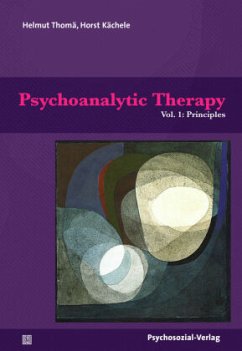- Gebundenes Buch
- Merkliste
- Auf die Merkliste
- Bewerten Bewerten
- Teilen
- Produkt teilen
- Produkterinnerung
- Produkterinnerung
The principles underlying psychoanalytic technique and their impact on practice are the main objects of this comprehensive and systematic study, which is based on research in psychoanalysis. By taking the differences between psychoanalytic schools and the finding of related disciplines into account, the authors describe new perspectives. After descriptions of the development of psychoanalysis, chapters are devoted to comprehensive accounts of the key concepts of the psychoanalytic therapy - transference, countertransference, and resistance - as well as to the initiation and conduct of…mehr
Andere Kunden interessierten sich auch für
![Practice / Psychoanalytic Therapy 2 Practice / Psychoanalytic Therapy 2]() Helmut ThomäPractice / Psychoanalytic Therapy 299,90 €
Helmut ThomäPractice / Psychoanalytic Therapy 299,90 €![Die psychoanalytisch-interaktionelle Gruppenpsychotherapie Die psychoanalytisch-interaktionelle Gruppenpsychotherapie]() Ulrich StreeckDie psychoanalytisch-interaktionelle Gruppenpsychotherapie19,90 €
Ulrich StreeckDie psychoanalytisch-interaktionelle Gruppenpsychotherapie19,90 €![Das Risiko der Verbundenheit Das Risiko der Verbundenheit]() Chris JaenickeDas Risiko der Verbundenheit29,90 €
Chris JaenickeDas Risiko der Verbundenheit29,90 €![Das Selbst und die inneren Objektbeziehungen Das Selbst und die inneren Objektbeziehungen]() William R. D. FairbairnDas Selbst und die inneren Objektbeziehungen34,90 €
William R. D. FairbairnDas Selbst und die inneren Objektbeziehungen34,90 €![Der Haß auf die Liebe Der Haß auf die Liebe]() Maurice HurniDer Haß auf die Liebe29,90 €
Maurice HurniDer Haß auf die Liebe29,90 €![Das Versagen der Diplomatie Das Versagen der Diplomatie]() Vamik D. VolkanDas Versagen der Diplomatie24,90 €
Vamik D. VolkanDas Versagen der Diplomatie24,90 €![Der Tod und das Leben Der Tod und das Leben]() Jürgen GrieserDer Tod und das Leben26,90 €
Jürgen GrieserDer Tod und das Leben26,90 €-
-
-
The principles underlying psychoanalytic technique and their impact on practice are the main objects of this comprehensive and systematic study, which is based on research in psychoanalysis. By taking the differences between psychoanalytic schools and the finding of related disciplines into account, the authors describe new perspectives. After descriptions of the development of psychoanalysis, chapters are devoted to comprehensive accounts of the key concepts of the psychoanalytic therapy - transference, countertransference, and resistance - as well as to the initiation and conduct of treatment, to the role of models, and to the scientific status of psychoanalytic theory. Psychoanalysis, understood in such terms, can be applied to a broad spectrum of mental disorders and psychosomatic illnesses.
Hinweis: Dieser Artikel kann nur an eine deutsche Lieferadresse ausgeliefert werden.
Hinweis: Dieser Artikel kann nur an eine deutsche Lieferadresse ausgeliefert werden.
Produktdetails
- Produktdetails
- Bibliothek der Psychoanalyse
- Verlag: Psychosozial-Verlag
- Artikelnr. des Verlages: 2951
- Seitenzahl: 563
- Erscheinungstermin: März 2020
- Englisch
- Abmessung: 244mm x 173mm x 44mm
- Gewicht: 1157g
- ISBN-13: 9783837929515
- ISBN-10: 3837929515
- Artikelnr.: 58319869
- Herstellerkennzeichnung Die Herstellerinformationen sind derzeit nicht verfügbar.
- Bibliothek der Psychoanalyse
- Verlag: Psychosozial-Verlag
- Artikelnr. des Verlages: 2951
- Seitenzahl: 563
- Erscheinungstermin: März 2020
- Englisch
- Abmessung: 244mm x 173mm x 44mm
- Gewicht: 1157g
- ISBN-13: 9783837929515
- ISBN-10: 3837929515
- Artikelnr.: 58319869
- Herstellerkennzeichnung Die Herstellerinformationen sind derzeit nicht verfügbar.
EndorsementChrista Rohde-DachserForeword to the Second English EditionPeter FonagyPreface to the Second English EditionIntroductionHistorical BackgroundSignpost1 Psychoanalysis: The Current State1.1 Our Position1.2 The Psychoanalyst's Contribution1.3 Crisis of Theory1.4 Metaphors1.5 Training and Research1.6 Directions and Currents1.7 Sociocultural Change1.8 Convergences and Divergences2 Transference and Relationship2.1 Transference as Repetition 2.2 Transference as Unconscious Schema2.3 Suggestion, Suggestibility, and Transference2.4 Dependence of Transference Phenomena on Technique2.5 Transference Neurosis as an Operational Concept2.6 A Controversial Family of Concepts: Real Relationship, Therapeutic Alliance, Working Alliance, and Transference2.7 The New Object as Subject: From Object Relationship Theory to Two-Person Psychology2.8 The Recognition of Actual Truths2.9 The Here-and-Now in a New Perspective2.10 Intersubjectivity, Bifocality of Transference and the Third3 Countertransference3.1 Countertransference: The Cinderella in Psychoanalysis3.2 Stage Two: Positive Aspects of Countertransference3.3 Stage Three: Countertransference in Intersubjective Psychoanalysis 3.4 Specific Issues Related to Countertransference3.4.1 Consequences and Problems of the Comprehensive Conception3.5 Concordance and Complementarity of Countertransference3.6 Should the Analyst Admit Countertransference or Not?3.7 How to Deal with Countertransference in Clinical Work?4 Resistance4.1 General Factors4.1.1 Classification of the Forms of Resistance4.1.2 Function of Resistance in Regulating Relationships4.1.3 Resistance and Defense4.2 Anxiety and the Protective Function of Resistance4.3 Repression and Transference Resistance4.4 Id and Superego Resistance4.4.1 The Negative Therapeutic Reaction4.4.2 Aggression and Destructiveness: Beyond the Mythology of Instinct4.5 Secondary Gain from Illness4.6 Identity Resistance and the Safety Principle5 Interpretation of Dreams5.1 Freud's Theory of Dreams and Dreaming5.2 Theoretical Remarks on Freud's Theory5.3 Day Residue and Infantile Wish5.3.1 Wish Fulfilment Theory: A Unifying Principle of Explanation5.3.2 Self-Representation and Problem Solving5.4 Self-Representation Theory and Its Consequences5.5 Clinical Dream Research5.6 Experimental Dream Research5.7 Technique of Dream Interpretation5.7.1 General Points of View5.7.2 Freud's Recommendations and Later Extensions6 The Initial Interview and the Latent Presence of Third Parties6.1 The Problem6.2 Diagnosis 6.3 Therapeutic Aspects 6.4 Decision Process 6.5 The Patient's Relatives 6.5.1 The Burden on the Relatives6.5.2 Typical Situations 6.6 Third-Party Payment6.6.1 Psychoanalysis and the German Health Insurance System6.6.2 The Impact on the Psychoanalytic Process7 Rules7.1 The Multiple Functions of Psychoanalytic Rules 7.2 Free Association: The Fundamental Rule of Therapy7.2.1 Features and Development7.2.2 Instructing the Patient About the Fundamental Rule7.2.3 Free Association in the Analytic Process7.3 Evenly Suspended Attention 7.4 The Psychoanalytic Dialogue and the Counterquestion Rule7.4.1 The Foundation and History of the Stereotype7.4.2 Rules Governing Cooperation and Discourse7.4.3 Object Finding and Dialogue8 Means, Ways, and Goals8.1 Time and Place8.2 Psychoanalytic Heuristics8.3 Specific and Nonspecific Means8.3.1 General Points of View8.3.2 Remembering and Reconstruction8.3.3 Intervention, Reaction, and Insight8.3.4 New Beginning and Regression8.4 Transference Interpretations and Reality8.5 Silence8.6 Acting Out and Enactment 8.6.1 Acting Out and Action in Psychoanalysis 8.6.2 The Irruption of the Enactment8.7 Working Through 8.8 Learning and Restructuring 8.9 Termination 8.9.1 General Considerations 8.9.2 Duration and Limitation 8.9.3 Criteria for Termination 8.9.4 The Postanalytic Phase 9 The Psychoanalytic Process9.0 Process or Process
EndorsementChrista Rohde-DachserForeword to the Second English EditionPeter FonagyPreface to the Second English EditionIntroductionHistorical BackgroundSignpost1 Psychoanalysis: The Current State1.1 Our Position1.2 The Psychoanalyst's Contribution1.3 Crisis of Theory1.4 Metaphors1.5 Training and Research1.6 Directions and Currents1.7 Sociocultural Change1.8 Convergences and Divergences2 Transference and Relationship2.1 Transference as Repetition 2.2 Transference as Unconscious Schema2.3 Suggestion, Suggestibility, and Transference2.4 Dependence of Transference Phenomena on Technique2.5 Transference Neurosis as an Operational Concept2.6 A Controversial Family of Concepts: Real Relationship, Therapeutic Alliance, Working Alliance, and Transference2.7 The New Object as Subject: From Object Relationship Theory to Two-Person Psychology2.8 The Recognition of Actual Truths2.9 The Here-and-Now in a New Perspective2.10 Intersubjectivity, Bifocality of Transference and the Third3 Countertransference3.1 Countertransference: The Cinderella in Psychoanalysis3.2 Stage Two: Positive Aspects of Countertransference3.3 Stage Three: Countertransference in Intersubjective Psychoanalysis 3.4 Specific Issues Related to Countertransference3.4.1 Consequences and Problems of the Comprehensive Conception3.5 Concordance and Complementarity of Countertransference3.6 Should the Analyst Admit Countertransference or Not?3.7 How to Deal with Countertransference in Clinical Work?4 Resistance4.1 General Factors4.1.1 Classification of the Forms of Resistance4.1.2 Function of Resistance in Regulating Relationships4.1.3 Resistance and Defense4.2 Anxiety and the Protective Function of Resistance4.3 Repression and Transference Resistance4.4 Id and Superego Resistance4.4.1 The Negative Therapeutic Reaction4.4.2 Aggression and Destructiveness: Beyond the Mythology of Instinct4.5 Secondary Gain from Illness4.6 Identity Resistance and the Safety Principle5 Interpretation of Dreams5.1 Freud's Theory of Dreams and Dreaming5.2 Theoretical Remarks on Freud's Theory5.3 Day Residue and Infantile Wish5.3.1 Wish Fulfilment Theory: A Unifying Principle of Explanation5.3.2 Self-Representation and Problem Solving5.4 Self-Representation Theory and Its Consequences5.5 Clinical Dream Research5.6 Experimental Dream Research5.7 Technique of Dream Interpretation5.7.1 General Points of View5.7.2 Freud's Recommendations and Later Extensions6 The Initial Interview and the Latent Presence of Third Parties6.1 The Problem6.2 Diagnosis 6.3 Therapeutic Aspects 6.4 Decision Process 6.5 The Patient's Relatives 6.5.1 The Burden on the Relatives6.5.2 Typical Situations 6.6 Third-Party Payment6.6.1 Psychoanalysis and the German Health Insurance System6.6.2 The Impact on the Psychoanalytic Process7 Rules7.1 The Multiple Functions of Psychoanalytic Rules 7.2 Free Association: The Fundamental Rule of Therapy7.2.1 Features and Development7.2.2 Instructing the Patient About the Fundamental Rule7.2.3 Free Association in the Analytic Process7.3 Evenly Suspended Attention 7.4 The Psychoanalytic Dialogue and the Counterquestion Rule7.4.1 The Foundation and History of the Stereotype7.4.2 Rules Governing Cooperation and Discourse7.4.3 Object Finding and Dialogue8 Means, Ways, and Goals8.1 Time and Place8.2 Psychoanalytic Heuristics8.3 Specific and Nonspecific Means8.3.1 General Points of View8.3.2 Remembering and Reconstruction8.3.3 Intervention, Reaction, and Insight8.3.4 New Beginning and Regression8.4 Transference Interpretations and Reality8.5 Silence8.6 Acting Out and Enactment 8.6.1 Acting Out and Action in Psychoanalysis 8.6.2 The Irruption of the Enactment8.7 Working Through 8.8 Learning and Restructuring 8.9 Termination 8.9.1 General Considerations 8.9.2 Duration and Limitation 8.9.3 Criteria for Termination 8.9.4 The Postanalytic Phase 9 The Psychoanalytic Process9.0 Process or Process








